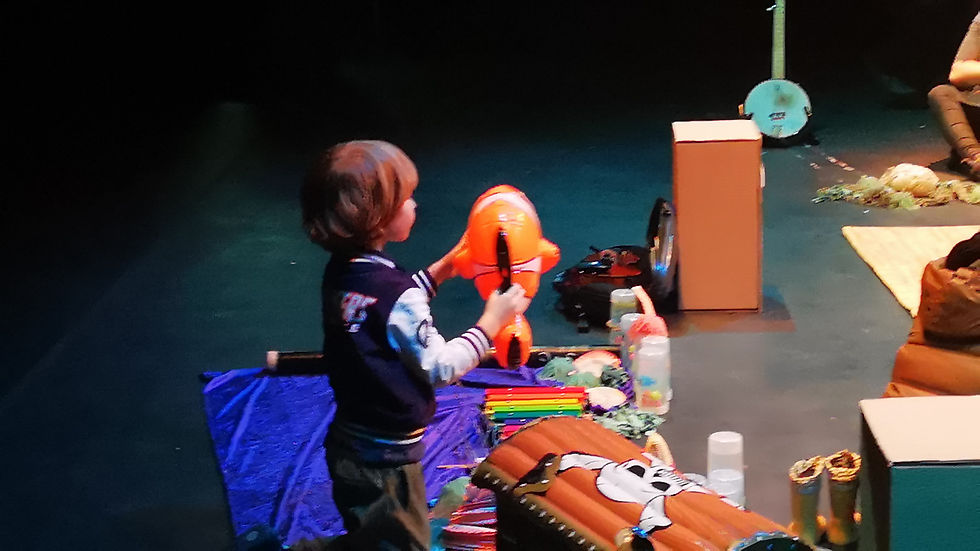Sea Hear!: Working with Kabantu to make Immersive Music-Theatre for Early Years.
- charlottearculus

- Feb 20, 2020
- 3 min read

It was the vitality of musicianship that drew me to accept the invitation to work on this show. After a phone call with percussionist Delia Stevens about the project, I checked out Kabantu’s website. I got very excited thinking about what these musicians could make with an early year’s audience. Delia had said the two magic words ‘immersive’ and ‘interactive’ to me. This was not to be some worthy but passive performance for children to sit and watch, Sea Hear! wanted to be an ‘encounter with music’ for our youngest children. The show had been commissioned by Lancaster Arts through the Big Imaginations network. A commission of new work for very young children. The concept for the show, its songs and its staging had already been devised by Kabantu. My job was to make those choices work in the best possible way for an early year’s audience.
We worked on transitions and invitations – the essentials of both immersive theatre and working with young children. How to invite children into the music through duets on a crab’s shell, through ringing bell-fish, movement and dance. How to extend transitions so that they become wonderous and magical rather than problematic. We removed all talking and script leaving only the words of the songs. This opened up spaces for clowning, absurdity and imagination. Improvisation is the critical skill in arts and early years. Improvisation whether in music, dance or theatre requires attention, shared rhythms and Complicité a French term used in ensemble work meaning a dynamic, sensed, attuned, force between players; a moving or murmurating with. The existing Complicité between Kabantu players made the devising process vibrant and joyful and the performance magical.

One of the problematics of early years theatre is the threshold-crossing of young audiences into an unfamiliar and strange space. Young children have no protocol to behave in a particular manner and this is why it is so critical that performances for people this age do not overly pre-conceive what the audience will do but rather leave wide and open-ended possibilities. I will give the example of one family that came in, with a toddler and a young child of around 3 years. The staging of the piece was around the audience who would sit in the middle aboard a ‘ship’. In the huge black box theatre this space sang with light, inviting the audience. Around the ‘ship’ on 3 sides were micro sets. Tactile assemblages on the floor without barriers. On entering the space, the 3-year-old child avoided this centre area. Leaving his family, he explored the darker edges of the large theatre space. There were a number of potential tensions here. Would his family become anxious about his not being with everyone else? Was he ok? During the opening piece the child came around the set and positioned himself within a micro set that the performers would move to next. He began playing with an inflatable fish. At no point did anyone attempt to move him, to tell him what to do, to narrate or ask him questions of his experience. Rather, his position was validated by a performer who invited him to duet on a drum with her – an invitation he accepted. The next transition brought the performers to his micro set. During this transition the child began to expressively dance and move with his fish, following the swirling music and movement of the musicians who came around him, accommodated him, accepted him. From being on the edge of things, the child became in the centre of all that was happening. The performer-child-music-micro set assemblage became a vital and exuberant event pulling everyone towards it. The skilled Kabantu performers picked up on this feeling of vitality and the whole thing took off.

Children who do different, who go to the edges of things, follow their feelings and curiosities, children who move as they listen as they sing as they watch as they make sense. These are the children who can be excluded and problematised by adult conceptions of what theatre or concerts should be. Performance for early years needs to have open-ended approaches built in or it is not fit for purpose. This requires the fundamental and critical ability to improvise so that we can learn from children in the moment. The Kabantu performers were able to embrace a multitude of unknowns with awareness of their audience and complicité with each other so that the performance was fresh and vital playing to both children and adults and filling both with wonder.



Comments